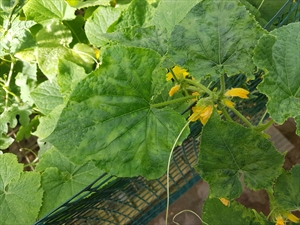Cucumber green mottle mosaic
Pacific Pests, Pathogens and Weeds - Online edition
Pacific Pests, Pathogens & Weeds
Cucumber green mottle mosaic (422)
Cucumber green mottle mosaic virus. It is a member of the tobamosaic genus. The official abbreviation is CGMMV. There are several strains.
Asia, Africa (restricted), North and South America, Europe, Oceania. It is recorded from Australia.
Members of the cucumber family, the Cucurbitaceae, are hosts: cucumber, bitter and bottle gourds, melon, and watermelon. Several wild species in the amaranth, cucumber, potato and other families, are hosts.
A very serious disease of cucurbit vegetables and fruits affecting yield and quality, which is difficult to manage. The virus is spread easily and remains viable for a long time in plant debris, soil, water and on equipment.
Symptoms vary depending on host, and even variety:
- cucumber - crumpling, green mottling and mosaic patterns on young leaves (Photos 1&2); fruits with irregular light green spots or streaks; plants may collapse.
- watermelon - stunting, mottling and mosaic patterns on leaves (Photo 3), areas of rot on the stems and fruit stalks; fruits may show internal discolouring or rots. Plants may die early.
- melon - mottling and mosaics on leaves, deformities and mottling on fruit.
- pumpkin - no symptoms or mottling/mosaics on leaves or fruits.
- squash/zucchini - no symptoms or mottling/mosaics on leaves; internal discolouring or rots of fruits.
Spread occurs in many ways over short and long distances, but movement in seed and soil are the most important. Other ways of spread include: handling (e.g., pruning, staking), grafting to tolerant rootstocks, infected leaves rubbing against those that are healthy, bees during pollination, in manures, hydroponic nutrient solutions, irrigation water, on tools, machinery, clothing, soil, and by root-to-root contact.
Survival of the virus between crops occurs in contaminated seed, crop debris and soil. It is a highly stable virus.
Outbreaks of the disease have occurred in many countries, reducing yields and marketability of fruits of cucumber and watermelon, in particular. Yield losses to local and export industries can be substantial.
Look for the mottles and mosaics of leaves, and internal symptoms of fruits. However, because of the variability of symptoms and similarity with other viruses affecting cucurbits, conformation requires serological or molecular methods.
BIOSECURITY
In recent years, the virus has spread with increasing speed and is now present in all major regions except South America. For those countries yet free from the virus, it is recommended that seed is certified free from the virus or samples are tested in quarantine using internationally accepted procedures. Similarly, quarantines should apply to the international exchange of plant germplasm.
CULTUTRAL CONTROL
Before planting:
- Use seed from a reputable commercial source that has been tested for CGMMV.
- Check each seedling in the nursery for signs of the disease before field planting. If signs are seen, incinerate the infected plant(s) and those 1 m around.
- Use disposable gloves when grafting plants.
During growth:
- Remove weeds from within and around cucurbit crops.
- Inspect crops in the field at regular intervals.
- Develop a biosecurity plan for the farm that includes hygiene measures and restricting visitors (and cars) from entering the property and/or fields. Only allow essential services and people to visit cropping and packaging areas.
After harvest:
- Collect debris - plant remains, plastic mulch, stakes and weeds - and destroy by burning or burying. Alternatively, the remains of infested plants and weeds can be composted.
- Clean plant trays, tools and machinery as appropriate using high pressure water, detergent or disinfectant (e.g., bleach - 1% sodium hypochlorite).
- Use a 2-year crop rotation in land where infections have occurred. In tropical countries, rotate with maize, sorghum or crops in the cabbage family.
RESISTANT VARIETIES
There are varieties that are tolerant to the virus, that is, they become infected, but the impact is less than on older varieties. Check catalogues of seed companies for details. Resistant varieties are produced by grafting cucumber and watermelon on rootstocks to prevent soilborne infections.
CHEMICAL CONTROL
Not a method that can be used against this disease.
AUTHOR Grahame Jackson
Information from CABI (2019) Cucumber green mottle mosaic virus. Crop Protection Compendium. (https://www.cabi.org/cpc/datasheet/17123); and Cucumber green mottle mosaic virus. A seed production and commercial growers guide. Asta and California Seed Association (http://www.calseed.org/documents/Website%20Linked%20Articles/CGMMV%20Brochure%20rev2.pdf); Cucumber green mottle mosaic virus (CGMMV) Fact Sheet. PIRSA. South Australia. (https://www.pir.sa.gov.au/__data/assets/pdf_file/0009/295767/Cucumber_Green_Mottle_Mosaic_Virus_Fact_Sheet_-_June_2019.pdf). Photos 1-3 Department of Primary Industry and Resources. Northern Territory, Australia.
Produced with support from the Australian Centre for International Agricultural Research under project HORT/2016/185: Responding to emerging pest and disease threats to horticulture in the Pacific islands, implemented by the University of Queensland and the Secretariat of the Pacific Community.






